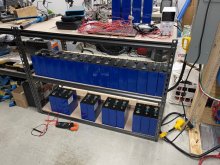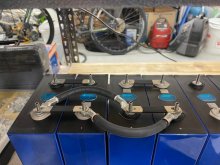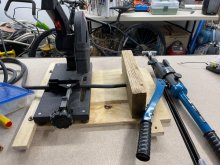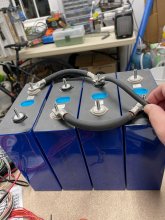The last of 36 cells will have been tested tomorrow. Whew!
I've completely disassembled my battery and am toying with a completely different setup. I'm going to try 8 packs of 4 cells with molex and anderson connectors so I never have to unscrew a terminal again and to keep the system modular. Here's the area in the RV in which the cells and equipment will go.
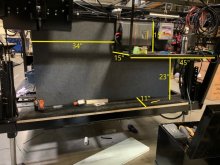
Cells across the bottom, two rows (I'll have them build a shelf). Most of the equipment in the upper right will be deleted and replaced with my 48-12v converter and 12v LFP battery. To the left and above the cells will be the various Victron equipment.
In this picture you're underneath the hitch of the 5th wheel, facing into the basement. There will be two LARGE doors providing equipment access. The area is part of the heated basement. The other side of the wall is the basement/storage. As such, I won't build a battery box - just 8 small fixtures to hold 4 cells each. That's the thought, anyway.
I plan to parallel the cells with the provided bus bars but I will serial-connect each of the two cells to their pairs/mates using 2 separate 4 gauge wires for an effective 1 gauge setup. Even if I turn everything on in the RV I won't pull more than 150 amps. Picture will be easier - once I have it. So, cell 1 positive connected to cell 2 positive with bus bar. Cell 3 negative connected to cell 4 negative with bus bar. Cell 1 positive connected to cell 3 negative with 4 gauge. Cell 2 positive connected to cell 4 negative with 4 gauge. Cell 1 negative and cell 2 negative become battery negative and cell 3 positive and cell 4 positive become battery positive (again using two independent 4 gauge wires). Two 4 gauge wires is exactly a single 1 gauge wire so I can stuff two of them into a 1 gauge lug, crimp, and get my battery connections. This way the cells are "perfectly" in series and the bus bars are only fixing small current differences / balancing the cells. It's a lot of wire and crimping. I will start with 32 wires directly connecting in series and test that this holds up. If it does, I'll invest in the Andreson connectors (not cheap!). The molex connectors are for the BMS leads. Then, the groups of 4 cells can be independently serviced and transported. It also means I have a LOT less to worry about with respect to proper compression fixtures for strings of 8 cells and greatly reduces the possibility of cell movement. After watching how loose my cells got in my fixture when they got to near 0 SOC, this is the way to go for me in this mobile application. It's either this, or 8-cell fixtures with springs. I could still be convinced to go that way. 8 fixtures is a lot, 4 is easier - and while I'll incur the cost of springs, I'll reduce the cost of Anderson connectors.
One thing on my mind is that if a cell becomes a lot weaker than its mate, one of the two wires will take more current .. and perhaps my design needs to include worst-case current for a single wire and not depend on the current being relatively evenly divided. Unlike my previous ruminations, the cell pairs will be matched by capacity (as opposed to pairing highest with lowest) - so the chance of this happening should be low. But I don't want to burn down my RV

The RV's due date is moved out to March 30th now

At least I have time to continue experimenting with the design.





